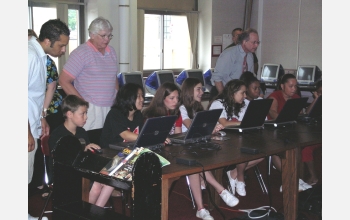All Images
News Release 05-063
Education Magnified 100,000X
Lab simulator packs teaching power of electron microscope at the expense of a textbook
This material is available primarily for archival purposes. Telephone numbers or other contact information may be out of date; please see current contact information at media contacts.

To say a scanning electron microscope (SEM) is a complex tool is an understatement. The table-sized machines, which generally cost as much as a house, are some of the most advanced instruments in the research arsenal.
For researchers who use an SEM, the value of the instrument is without measure. To magnify 3-D objects more than 100,000 times their normal appearance or measure tiny features only millionths of a meter across, few tools can compete.
While traditional optical, or light, microscopes have proved to be incredibly valuable, some researchers require a greater depth of field to resolve features smaller than the 0.20 micron (millionth of a meter) limit imposed on the scopes by the available wavelengths of visible light.
SEMs can differentiate details down to less than 100 Ångstroms (ten-billionths of a meter) and at enormous magnifications. To put this in perspective, a typical carpenter ant is about 6.5 millimeters long. If you increased the ant's size 100,000 times, it would be about twice as long as a Nimitz-class aircraft carrier.
For kids, and even many college students, this mainstay of research is not only out of reach, it is unknown.
The Interactive Scanning Electron Microscope (iSEM) project may bridge that knowledge gap. NSF-supported researchers and software developers at the RJ Lee Group created an interactive SEM simulator for the classroom, and teachers associated with ASSET, Inc. worked with the developers to create an educational package that has the simulator at its core.
By applying the critical functions of an SEM--such as pan and zoom, precision measurement and the display of high-resolution images--the simulator introduces not only science and technology, but also familiarity with advanced research tools.
To introduce the value of such instrumental analyses, while keeping users entertained, iSEM incorporates real SEM images -- mosaics comprised of hundreds of data sets patched into a single picture. Just as with the real scope, students can pan over an object such as a spider and zoom-in on important features. The educational module asks specific questions about the displayed subject, such as the length of a spider's fang. The students can use the iSEM tools to determine a precise measurement -- to within roughly 1 micron.
The educational modules are based on state and national standards and will evolve as iSEM does. Currently, the developers are working on simulators for a variety of other research tools, such as optical microscopes and high-resolution cameras. With these modules, students will learn to identify minerals in meteorites and other rocks, determine the geologic history of a landscape and draw conclusions about surface features on Mars.
Credit: RJ Lee Group

Students in Steubenville, Ohio, explore iSEM.
Credit: RJ Lee Group
Download the high-resolution JPG version of the image. (413 KB)
Use your mouse to right-click (Mac users may need to Ctrl-click) the link above and choose the option that will save the file or target to your computer.

The iSEM interface incorporates a number of features that help students observe fine detail in high-resolution SEM images. This image is of the iSEM demonstration version.
Credit: RJ Lee Group
Download the high-resolution JPG version of the image. (216 KB)
Use your mouse to right-click (Mac users may need to Ctrl-click) the link above and choose the option that will save the file or target to your computer.


